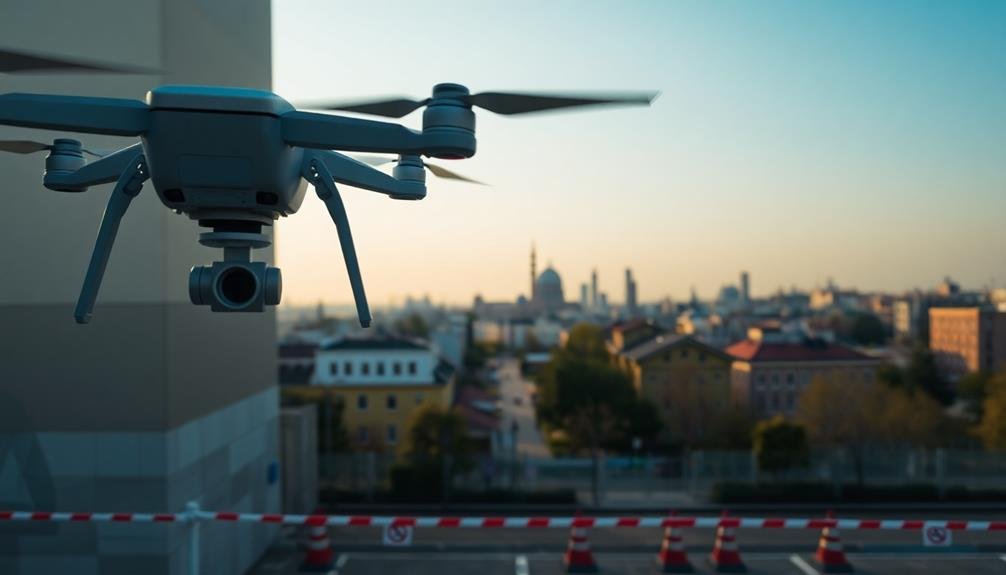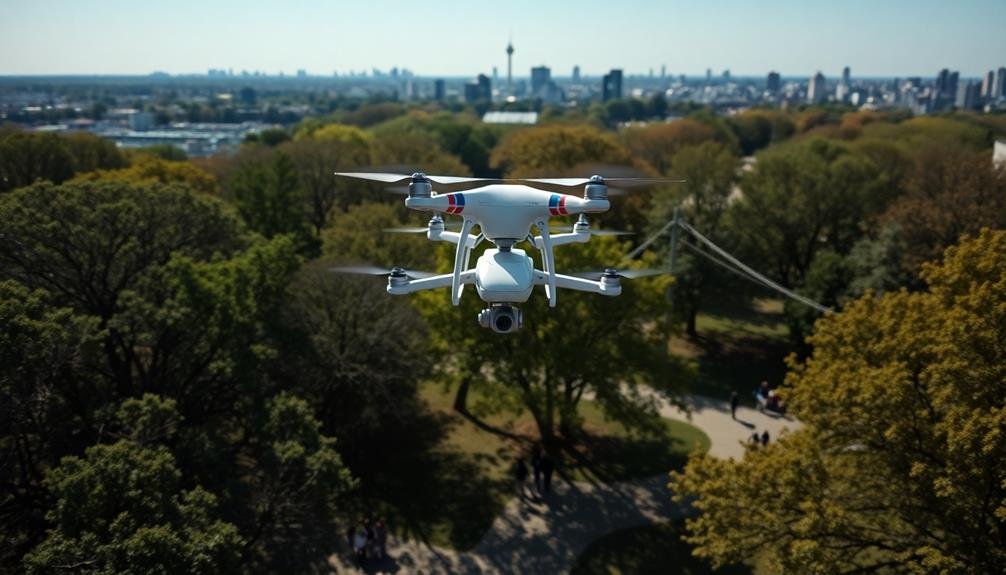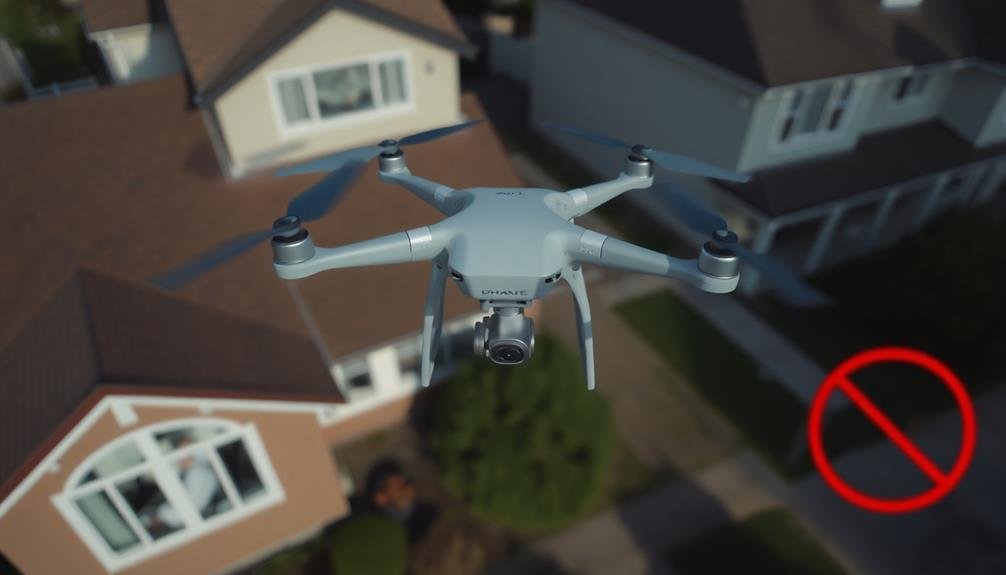When flying your drone for photography, you must follow seven essential laws. First, register your drone with the FAA if it weighs between 0.55 and 55 pounds. Next, obtain the necessary certifications like TRUST for recreational use or a Remote Pilot Certificate for commercial operations. Always respect no-fly zones, including airports and national parks. Maintain visual line of sight with your drone at all times. Follow altitude restrictions, typically staying below 400 feet. Avoid flying over people to guarantee safety and privacy. Finally, understand and comply with privacy laws to protect individuals' rights. These guidelines are just the beginning of responsible drone operation.
Key Takeaways
- Register your drone with the FAA if it weighs between 0.55 and 55 pounds.
- Obtain necessary certifications: TRUST for recreational pilots, Remote Pilot Certificate for commercial operators.
- Respect no-fly zones, including airports, national parks, and areas with Temporary Flight Restrictions.
- Maintain visual line of sight with your drone and follow altitude restrictions (maximum 400 feet for recreational use).
- Avoid flying over people and respect privacy laws by not capturing images of individuals without consent.
Register Your Drone

The first step in complying with drone photography laws is to register your drone. In the United States, the Federal Aviation Administration (FAA) requires registration for all unmanned aircraft systems (UAS) weighing between 0.55 and 55 pounds. This includes most consumer and professional drones used for photography.
To register, you'll need to visit the FAA's DroneZone website. You must be at least 13 years old and provide your name, address, and email. The registration fee is $5 and is valid for three years. Once registered, you'll receive a unique identification number that must be displayed on your drone.
If you're flying recreationally, you can use the same registration number for all your drones. However, if you're flying for commercial purposes, each drone needs its own registration.
After registering, you'll receive a certificate that you should carry with you when flying.
Obtain Necessary Certifications

In addition to registering your drone, you'll need to obtain the proper certifications before taking to the skies for photography. The Federal Aviation Administration (FAA) requires drone pilots to pass specific tests and obtain licenses depending on their intended use.
For recreational drone photographers, you'll need to pass The Recreational UAS Safety Test (TRUST). It's free, online, and covers basic safety rules and regulations.
If you plan to use your drone for commercial purposes, including selling your photos or videos, you must obtain a Remote Pilot Certificate by passing the Part 107 test.
The Part 107 test covers more extensive knowledge, including:
- Airspace classifications and regulations
- Weather patterns and their effects on drone operations
- Emergency procedures and radio communication protocols
- Drone maintenance and preflight inspection procedures
- Understanding aeronautical charts and flight planning
Once certified, you'll need to renew your license every two years.
Keep in mind that local laws may require additional permits or certifications, so always check your area's specific requirements.
Respect No-Fly Zones

Where can you legally fly your drone for photography? Understanding and respecting no-fly zones is vital for responsible drone operation. These restricted areas are established to protect public safety, national security, and privacy.
You must avoid flying near airports, military bases, and other sensitive locations. The Federal Aviation Administration (FAA) prohibits drone flights within a 5-mile radius of airports without prior authorization. National parks, state parks, and many local parks also restrict or ban drone usage to protect wildlife and preserve visitors' experiences.
Always check for Temporary Flight Restrictions (TFRs) before flying. These can be imposed during emergencies, special events, or VIP movements. Use the FAA's B4UFLY mobile app or website to identify no-fly zones and airspace restrictions in your area.
Be aware of important infrastructure sites like power plants, prisons, and government buildings, which often have drone restrictions. Respect private property rights and don't fly over people's homes without permission.
In urban areas, be cautious of buildings, crowds, and potential hazards.
Maintain Visual Line of Sight

While capturing stunning aerial shots is exciting, you must always maintain visual line of sight with your drone. This means you should be able to see your drone at all times without the aid of any device other than corrective lenses. It's not just a safety measure; it's a legal requirement in many countries.
Maintaining visual line of sight helps you:
- Avoid collisions with obstacles or other aircraft
- Monitor your drone's behavior and position
- React quickly to unexpected situations
- Comply with local and national regulations
- Guarantee the safety of people and property on the ground
Don't rely solely on your drone's camera feed or FPV goggles. These tools can supplement your awareness but shouldn't replace your direct visual contact.
If you lose sight of your drone, land it immediately using your last known visual reference point. Be aware of your surroundings and potential obstructions that could block your view.
In some cases, you may need a visual observer to help maintain line of sight, especially in complex environments or during commercial operations.
Follow Altitude Restrictions

When flying your drone for photography, you must adhere to strict altitude restrictions.
The maximum legal flying height for recreational drones in most areas is 400 feet above ground level.
You'll need to be aware of different airspace classes, as some areas may have lower altitude limits or require special authorization for drone operations.
Maximum Legal Flying Height
For drone operators, understanding and adhering to altitude restrictions is vital. In most countries, the maximum legal flying height for recreational drones is 400 feet (120 meters) above ground level. This limit helps prevent conflicts with manned aircraft and guarantees safer airspace for everyone.
You'll need to be aware that this height restriction applies from the point where you've taken off, not sea level.
It's important to remember that certain areas may have lower altitude limits or even complete no-fly zones. Always check local regulations and use drone apps to stay informed about restrictions in your flying area.
Some situations where you might encounter different altitude limits include:
- Near airports or heliports
- In controlled airspace
- Around tall structures
- During special events
- In national parks or protected areas
If you're flying for commercial purposes, you may be able to obtain waivers for higher altitudes, but this requires special permission and training.
Always prioritize safety and stay within legal limits to avoid fines or legal issues. Remember, flying responsibly not only keeps you compliant but also helps maintain a positive image for the drone community.
Airspace Class Considerations
Understanding airspace classifications is key to safe and legal drone operation. As a drone photographer, you must familiarize yourself with the different airspace classes and their restrictions.
Class G airspace, which extends from the ground up to 400 feet in most areas, is typically where recreational and commercial drones operate. However, you'll need to be aware of controlled airspace near airports and other sensitive locations.
Class B, C, and D airspaces surround airports of varying sizes and require explicit authorization from air traffic control before flying. You'll need to use the FAA's LAANC system or submit a manual request for permission to operate in these areas.
Class E airspace often begins at 700 feet above ground level and may have specific restrictions.
Always check for Temporary Flight Restrictions (TFRs) and NOTAMs (Notices to Airmen) before each flight. These can temporarily alter airspace classifications and restrictions.
Remember that even in uncontrolled airspace, you're required to yield right-of-way to manned aircraft. By understanding and respecting airspace classifications, you'll guarantee your drone photography remains both legal and safe.
Avoid Flying Over People

Flying drones over people is generally prohibited and often illegal. This rule exists to protect people's safety and privacy. As a drone photographer, you're responsible for ensuring your aircraft doesn't pose a risk to others. Always keep your drone within your line of sight and maintain a safe distance from individuals and crowds.
When planning your flight, consider the area's population density and potential gatherings. Avoid flying over:
- Sporting events
- Concerts
- Public parks
- Beaches
- Busy streets
If you must capture footage in populated areas, scout the location beforehand to identify safe takeoff and landing spots. Look for open spaces away from people and buildings. Remember, even if you're not directly above someone, a malfunction could cause your drone to drift or fall unexpectedly.
Some drones have built-in obstacle avoidance systems, but don't rely solely on this technology. Stay vigilant and be prepared to manually override if necessary.
If you need to fly over people for a specific project, you'll need to obtain special permission from the FAA and follow strict safety protocols. Always prioritize safety over getting the perfect shot.
Understand Privacy Laws

Beyond safety concerns, drone photographers must navigate complex privacy laws. You need to be aware that individuals have a reasonable expectation of privacy, especially in their homes and private properties. Avoid capturing images or videos of people without their consent, particularly in areas where they'd expect privacy.
Familiarize yourself with local and state privacy laws, as they can vary greatly. Some states have specific drone privacy regulations, while others rely on existing privacy statutes. Generally, it's illegal to use drones for voyeurism, harassment, or stalking.
Here's a quick overview of privacy considerations:
| Location | Privacy Expectations | Best Practice |
|---|---|---|
| Public spaces | Lower | Be respectful, avoid closeups |
| Private property | Higher | Obtain permission |
| Sensitive areas | Highest | Avoid entirely |
Remember that even if you're flying in a public space, capturing images of private areas (like backyards or through windows) can be illegal. Always prioritize others' privacy rights and use common sense. If in doubt, err on the side of caution and seek legal advice or additional permissions before flying and capturing images in potentially sensitive areas.
Frequently Asked Questions
Can I Use a Drone for Commercial Purposes Without a License?
No, you can't use a drone for commercial purposes without a license. You'll need to obtain a Part 107 Remote Pilot Certificate from the FAA. It's crucial to comply with regulations to avoid legal issues.
Are There Specific Weather Conditions That Prohibit Drone Flight?
Yes, you shouldn't fly your drone in heavy rain, snow, fog, or strong winds. It's also unsafe to operate in extreme temperatures. Always check weather forecasts and avoid flying if conditions might compromise your drone's performance or safety.
How Do I Report Unsafe Drone Operations in My Area?
You can report unsafe drone operations by contacting your local law enforcement or the FAA. Use the FAA's online reporting system or call their hotline. Provide as much detail as possible, including the drone's location and activities.
What Insurance Options Are Available for Drone Operators?
You've got several insurance options as a drone operator. You can choose from liability insurance, hull coverage, and payload protection. Some providers offer specialized drone insurance packages. Don't forget to check if your existing policies cover drone operations too.
Can I Fly My Drone at Night With Proper Lighting?
You can fly your drone at night if you've proper lighting. You'll need anti-collision lights visible for 3 miles. Remember, you must follow FAA regulations, including obtaining a Part 107 waiver for nighttime operations.
In Summary
You've now got the essential knowledge to fly your drone legally and responsibly. Remember, these laws aren't just formalities; they're vital for safety and privacy. As you explore the skies, always keep these rules in mind. Stay informed about any changes in regulations, and you'll be able to capture stunning aerial shots while respecting others and staying on the right side of the law. Happy flying!

As educators and advocates for responsible drone use, we’re committed to sharing our knowledge and expertise with aspiring aerial photographers.




Leave a Reply